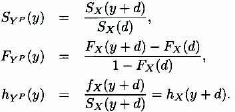8.2 Deductibles
Insurance policies are often sold with a per-loss deductible of d. When the loss, x, is at or below d, the insurance pays nothing. When the loss is above d, the insurance pays x − d. In the language of Chapter 3, such a deductible can be defined as follows.
Definition 8.1 An ordinary deductible modifies a random variable into either the excess loss or left censored and shifted variable (see Definition 3.3). The difference depends on whether the result of applying the deductible is to be per payment or per loss, respectively.
This concept has already been introduced along with formulas for determining its moments. The per-payment variable is
![]()
while the per-loss variable is
![]()
Note that the per-payment variable YP = YL|YL > 0. That is, the per-payment variable is the per-loss variable conditioned on the loss being positive. For the excess loss/per-payment variable, the density function is
noting that for a discrete distribution the density function need only be replaced by the probability function. Other key functions are

Note that as a per-payment variable the excess ...
Get Loss Models: From Data to Decisions, 4th Edition now with the O’Reilly learning platform.
O’Reilly members experience books, live events, courses curated by job role, and more from O’Reilly and nearly 200 top publishers.

